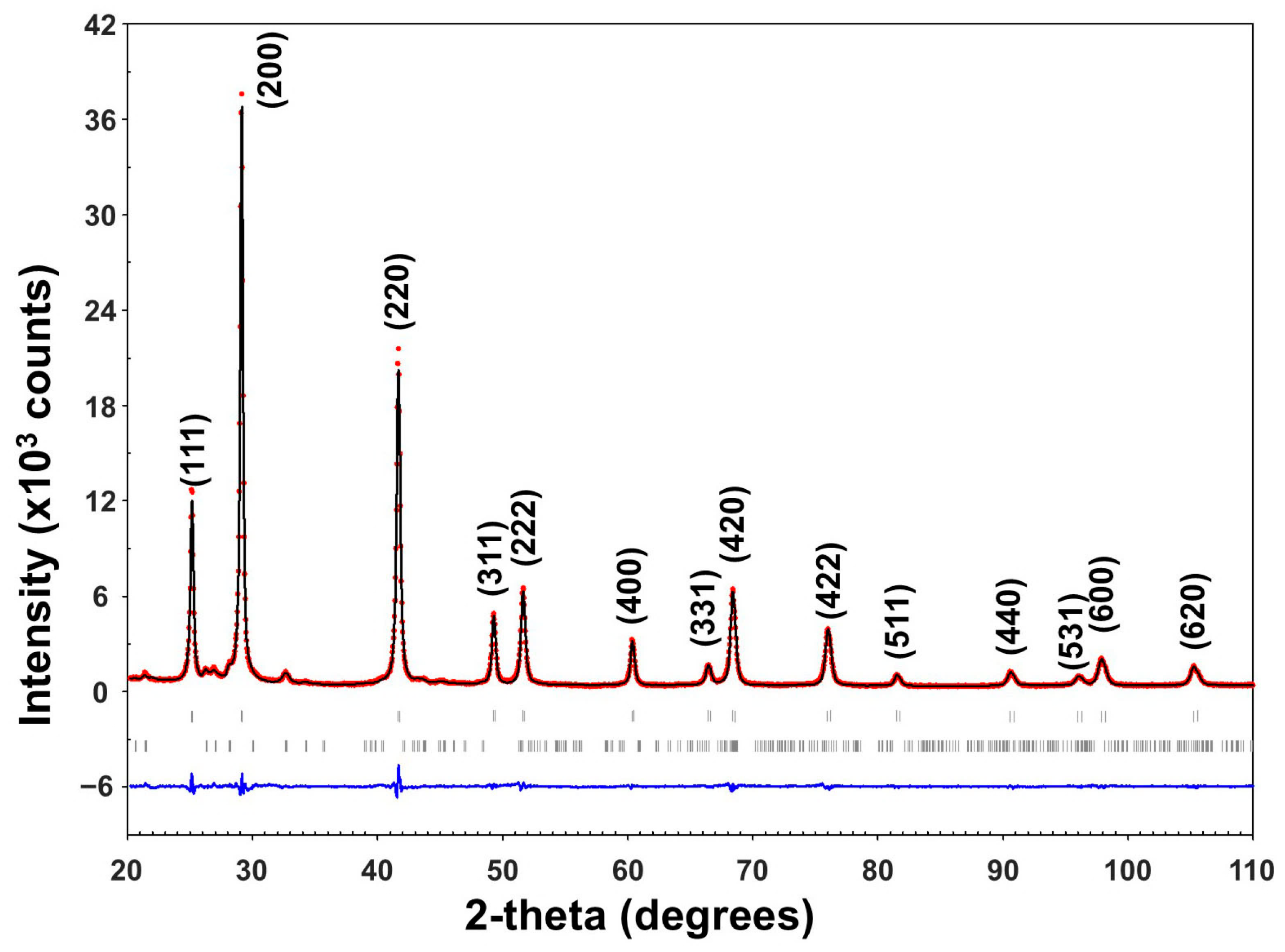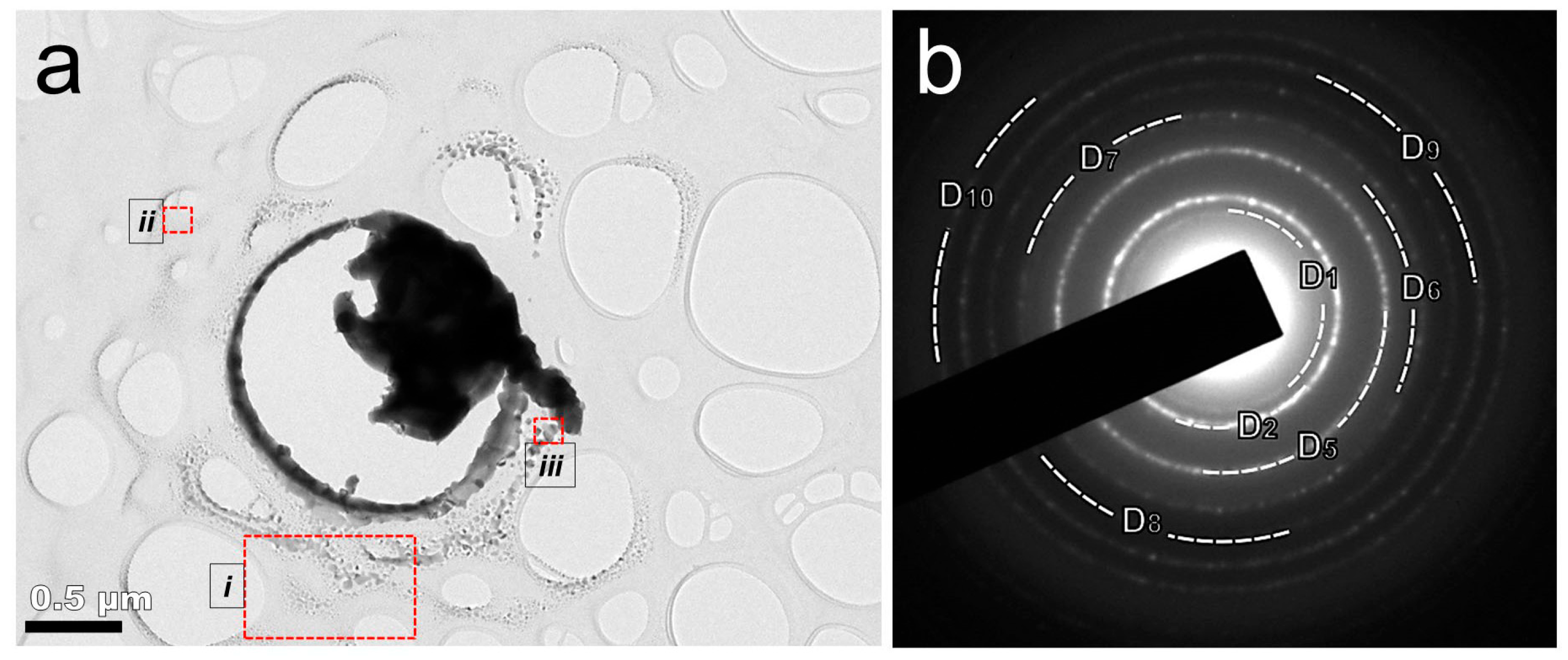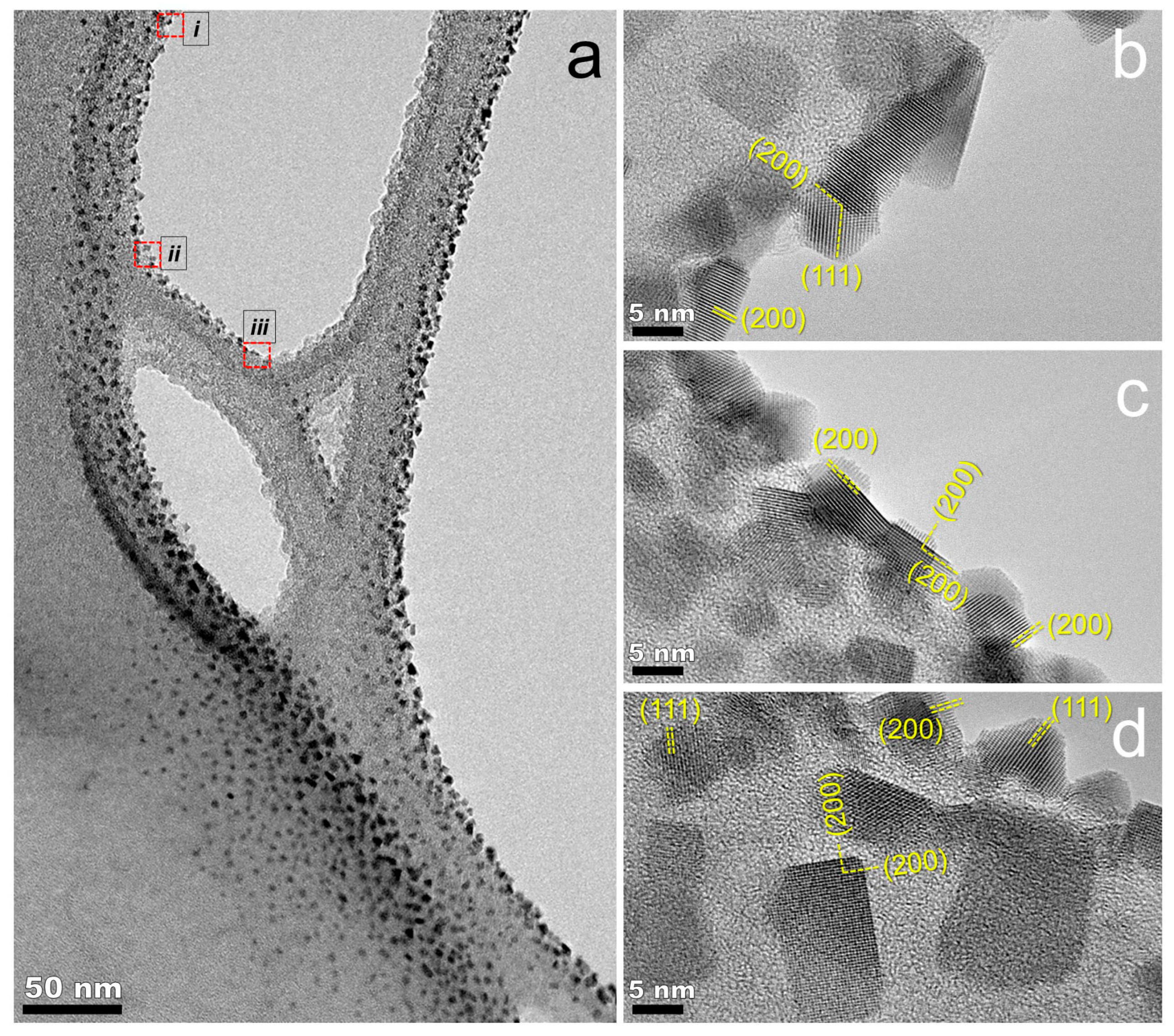Multi-Scale PbSe Structures: A Complete Transformation Using a Biphasic Mixture of Precursors
Abstract
1. Introduction
2. Materials and Methods
2.1. Materials
2.2. Sample Preparation and Milling Treatment
2.3. Bulk Characterization and Rietveld Refinement
2.4. Morphological Characterization
3. Results and Discussion
3.1. Bulk Characterization
3.2. TEM Analysis
3.2.1. Before Blasting the Biphasic Mixture with an Electron Beam
3.2.2. After Blasting the Biphasic Mixture with an Electron Beam
4. Conclusions
Author Contributions
Funding
Data Availability Statement
Acknowledgments
Conflicts of Interest
Abbreviations
| EB | Electron beam |
| EBI | Electron beam irradiation |
| HEM | High-energy milling |
| HRTEM | High-resolution transmission electron microscopy |
| SAED | Selected area electron diffraction |
| TEM | Transmission electron microscopy |
| XRD | X-ray diffraction |
References
- Luo, Q.; Wang, R.; Lu, K.; Liu, H.; Yuan, G.; Ding, J.; Lei, X.; Min, R.; Zhang, Q.; Huang, L. Boosting the Thermoelectric Properties of N-Type PbSe through the Dual Incorporation of Sb and Al. Mater. Today Commun. 2024, 41, 110718. [Google Scholar] [CrossRef]
- Sousa, V.; Savelli, G.; Lebedev, O.I.; Kovnir, K.; Correia, J.H.; Vieira, E.M.F.; Alpuim, P.; Kolen’ko, Y.V. High Seebeck Coefficient from Screen-Printed Colloidal PbSe Nanocrystals Thin Film. Materials 2022, 15, 8805. [Google Scholar] [CrossRef]
- Hou, Z.-H.; Qian, X.; Cui, Q.-J.; Wang, S.-F.; Zhao, L.-D. Strategies to Advance Thermoelectric Performance of PbSe and PbS Materials. Rare Met. 2024, 43, 4099–4114. [Google Scholar] [CrossRef]
- Sihmar, I.; Pandey, A.; Solet, V.K.; Chaudhary, N.; Goyal, N.; Pandey, S.K. Understanding the Transport Behaviour of PbSe: A Combined Experimental and Computational Study. Next Mater. 2025, 8, 100702. [Google Scholar] [CrossRef]
- Achimovičová, M.; Daneu, N.; Rečnik, A.; Ďurišin, J.; Peter, B.; Fabián, M.; Kováč, J.; Šatka, A. Characterization of Mechanochemically Synthesized Lead Selenide. Chem. Pap. 2009, 63, 562–567. [Google Scholar] [CrossRef]
- Achimovičová, M.; Baláž, P.; Ďurišin, J.; Daneu, N.; Kováč, J.; Šatka, A.; Feldhoff, A.; Gock, E. Mechanochemical Synthesis of Nanocrystalline Lead Selenide: Industrial Approach. Int. J. Mater. Res. 2011, 102, 441–445. [Google Scholar] [CrossRef]
- Piotrowski, M.; Franco, M.; Sousa, V.; Rodrigues, J.; Deepak, F.L.; Kakefuda, Y.; Kawamoto, N.; Baba, T.; Owens-Baird, B.; Alpuim, P.; et al. Probing of Thermal Transport in 50 Nm Thick PbTe Nanocrystal Films by Time-Domain Thermoreflectance. J. Phys. Chem. C 2018, 122, 27127–27134. [Google Scholar] [CrossRef]
- Badr, Y.; Mahmoud, M.A. Size-Dependent Spectroscopic, Optical, and Electrical Properties of PbSe Nanoparticles. Cryst. Res. Technol. 2006, 41, 658–663. [Google Scholar] [CrossRef]
- Rojas-Chávez, H.; Juárez-García, J.M.; Herrera-Rivera, R.; Flores-Rojas, E.; González-Domínguez, J.L.; Cruz-Orea, A.; Cayetano-Castro, N.; Ávila-García, A.; Mondragón-Sánchez, M.L. The High-Energy Milling Process as a Synergistic Approach to Minimize the Thermal Conductivity of PbTe Nanostructures. J. Alloys Compd. 2020, 820, 153167. [Google Scholar] [CrossRef]
- DeCoster, M.E.; Chen, X.; Zhang, K.; Rost, C.M.; Hoglund, E.R.; Howe, J.M.; Beechem, T.E.; Baumgart, H.; Hopkins, P.E. Thermal Conductivity and Phonon Scattering Processes of ALD Grown PbTe–PbSe Thermoelectric Thin Films. Adv. Funct. Mater. 2019, 29, 1904073. [Google Scholar] [CrossRef]
- Deng, Q.; Zhang, F.; Nan, P.; Zhang, Z.; Gan, L.; Chen, Z.; Ge, B.; Dong, H.; Mao, H.; Ang, R. Unique Semi-Coherent Nanostructure Advancing Thermoelectrics of N-Type PbSe. Adv. Funct. Mater. 2024, 34, 2310073. [Google Scholar] [CrossRef]
- Ma, L.; Mei, R.; Zhao, X.; Sun, H. Monte Carlo Simulation of Single-Crystalline PbSe Nanowire Thermal Conductivity Using First-Principle Phonon Properties. Semicond. Sci. Technol. 2017, 32, 095008. [Google Scholar] [CrossRef]
- Liu, S.; Qin, B.; Zhao, L.-D. PbSe Thermoelectrics: Efficient Candidates for Power Generation and Cooling. Adv. Energy Mater. 2025, 15, 2404251. [Google Scholar] [CrossRef]
- Xie, Y.; Deng, Q.; Yang, Y.; Luo, Y.; Ou, W.; Zhao, Z.; Luo, J.; Wu, H.; Ang, R. Pseudo-Nanostructuring and Grain Refinement Enhance the Near-Room-Temperature Thermoelectric Performance in n-Type PbSe. Small 2025, 21, 2408852. [Google Scholar] [CrossRef] [PubMed]
- Tanaka, S.-I. Control and Modification of Nanostructured Materials by Electron Beam Irradiation. Quantum Beam Sci. 2021, 5, 23. [Google Scholar] [CrossRef]
- Rojas-Chávez, H.; Daneu, N.; Valdés-Madrigal, M.A.; Carbajal-Franco, G.; Achimovičová, M.; Juárez-García, J.M. Fast Transformation of PbTe Using a Multiphase Mixture of Precursors: First Insights. Quantum Beam Sci. 2025, 9, 24. [Google Scholar] [CrossRef]
- Watanabe, M.; Someya, T.; Nagahama, Y. Temperature Rise of Specimen Due to Electron Irradiation. J. Phys. D Appl. Phys. 1970, 3, 1461. [Google Scholar] [CrossRef]
- Park, J.; Bae, K.; Kim, T.R.; Perez, C.; Sood, A.; Asheghi, M.; Goodson, K.E.; Park, W. Direct Quantification of Heat Generation Due to Inelastic Scattering of Electrons Using a Nanocalorimeter. Adv. Sci. 2021, 8, 2002876. [Google Scholar] [CrossRef]
- Koenig, C.; da Silva Fanta, A.B.; Jinschek, J.R. Measurement of Electron Beam Induced Sample Heating in SEM Experiments. Ultramicroscopy 2025, 276, 114195. [Google Scholar] [CrossRef]
- Skowron, S.T.; Chamberlain, T.W.; Biskupek, J.; Kaiser, U.; Besley, E.; Khlobystov, A.N. Chemical Reactions of Molecules Promoted and Simultaneously Imaged by the Electron Beam in Transmission Electron Microscopy. Acc. Chem. Res. 2017, 50, 1797–1807. [Google Scholar] [CrossRef]
- Sohn, W.; Kim, M.; Jang, H.W. Atomic-Scale Insights into the 2D Materials from Aberration-Corrected Scanning Transmission Electron Microscopy: Progress and Future. Small Sci. 2024, 4, 2300073. [Google Scholar] [CrossRef]
- Wahlqvist, D.; Mases, M.; Jacobsson, D.; Wiinikka, H.; Ek, M. Nanocarbon Oxidation in the Environmental Transmission Electron Microscope—Disentangling the Role of the Electron Beam. Carbon 2024, 218, 118686. [Google Scholar] [CrossRef]
- Sun, J.; Li, M.; Liu, H.; Guo, L.; Dong, X.; Liang, C. Transmission Electron Microscopy Analysis of Co3O4 Degradation Induced by Electron Irradiation. Micron 2025, 190, 103786. [Google Scholar] [CrossRef]
- Ilett, M.; S’ari, M.; Freeman, H.; Aslam, Z.; Koniuch, N.; Afzali, M.; Cattle, J.; Hooley, R.; Roncal-Herrero, T.; Collins, S.M.; et al. Analysis of Complex, Beam-Sensitive Materials by Transmission Electron Microscopy and Associated Techniques. Philos. Trans. R. Soc. A Math. Phys. Eng. Sci. 2020, 378, 20190601. [Google Scholar] [CrossRef]
- Long, N.J.; Petford-Long, A.K. In-Situ Electron-Beam-Induced Reduction of CuO: A Study of Phase Transformations in Cupric Oxide. Ultramicroscopy 1986, 20, 151–159. [Google Scholar] [CrossRef]
- Mücke, D.; Cooley, I.; Liang, B.; Wang, Z.; Park, S.; Dong, R.; Feng, X.; Qi, H.; Besley, E.; Kaiser, U. Understanding the Electron Beam Resilience of Two-Dimensional Conjugated Metal–Organic Frameworks. Nano Lett. 2024, 24, 3014–3020. [Google Scholar] [CrossRef]
- Atas, M.S. The Relationship between Reinforcement Ratio and E-Beam Irradiation in Y2O3 Reinforced Al6061 Alloys: A Crystallographic Assessment. Nucl. Instrum. Methods Phys. Res. Sect. B Beam Interact. Mater. At. 2024, 548, 165252. [Google Scholar] [CrossRef]
- Ghobashy, M.M.; Sharshir, A.I.; Zaghlool, R.A.; Mohamed, F. Investigating the Impact of Electron Beam Irradiation on Electrical, Magnetic, and Optical Properties of XLPE/Co3O4 Nanocomposites. Sci. Rep. 2024, 14, 4829. [Google Scholar] [CrossRef]
- Abdel Maksoud, M.I.A.; Fahim, R.A.; Kassem, S.M.; Gobara, M.; Awed, A.S. Revealing the Effects of Electron Beam Irradiation on the Structural, Optical, Thermal, and Dielectric Properties of PVC/Ag2WO4 Nanocomposite Films. Opt. Quantum Electron. 2024, 56, 710. [Google Scholar] [CrossRef]
- Lu, J.; Sui, X.; Novoselov, K.S.; Huang, P.; Xu, F.; Sun, L. Electron Beam-Assisted Synthesis and Modification of Electrode/Separator Materials for Lithium-Ion Batteries: Progress and Prospects. Coord. Chem. Rev. 2024, 515, 215954. [Google Scholar] [CrossRef]
- Kim, H.J.; Bae, H.B.; Park, Y.; Choi, S.H. Defect-Engineered Si1−xGex Alloy under Electron Beam Irradiation for Thermoelectrics. RSC Adv. 2012, 2, 12670–12674. [Google Scholar] [CrossRef]
- Rao, S.P.; Sahu, S.; Bano, N.; Shukla, D.K.; Dayal, V. Investigation of Low-Temperature Thermoelectric Properties of Si0.8Ge0.2 Alloy Irradiated by High Energy Electron Beam. Curr. Appl. Phys. 2024, 57, 33–41. [Google Scholar] [CrossRef]
- Oh, I.; Jo, J.; Park, J.; Lee, J.; Shin, H.; Yoo, J.-W. Local Crystallization and Enhanced Thermoelectric Performance of Glassy Carbon Induced by the Electron Beam Irradiation. Curr. Appl. Phys. 2016, 16, 1511–1516. [Google Scholar] [CrossRef]
- He, J.; Li, Z.; Lin, K.; Zhong, R.; Cao, H.; Xie, X.; Pu, G.; Wang, Z.; Wang, Y.; Yin, Q.; et al. High-Energy Electron Beam-Induced Enhanced Thermoelectric Performance and Irradiation Resistance of PEDOT: PSS. ACS Appl. Mater. Interfaces 2025, 17, 32894–32905. [Google Scholar] [CrossRef]
- Jiang, N. Electron Irradiation Effects in Transmission Electron Microscopy: Random Displacements and Collective Migrations. Micron 2023, 171, 103482. [Google Scholar] [CrossRef]
- Speckmann, C.; Mustonen, K.; Propst, D.; Mangler, C.; Kotakoski, J. Electron Irradiation Effects on Monolayer MoS2 at Elevated Temperatures. Phys. Rev. B 2025, 111, 054107. [Google Scholar] [CrossRef]
- Hu, J.; Sun, Y.; Chen, Z. Rapid Fabrication of Nanocrystals through in Situ Electron Beam Irradiation in a Transmission Electron Microscope. J. Phys. Chem. C 2009, 113, 5201–5205. [Google Scholar] [CrossRef]
- Zelenina, I.; Veremchuk, I.; Grin, Y.; Simon, P. In Situ Observation of Electron-Beam-Induced Formation of Nano-Structures in PbTe. Nanomaterials 2021, 11, 163. [Google Scholar] [CrossRef]
- Rojas-Chávez, H. Chemical Models to Map the Transformation from Precursors to Semiconductor Materials at Non-Equilibrium Conditions. RSC Mechanochem. 2025, 2, 723. [Google Scholar] [CrossRef]
- Rojas-Chávez, H.; Reyes-Carmona, F.; Achimovičová, M.; Daneu, N.; Jaramillo-Vigueras, D. PbSe Nanocubes Obtained by High-Energy Milling. J. Nanoparticle Res. 2012, 14, 897. [Google Scholar] [CrossRef]
- Díaz-Torres, E.; Flores-Conde, A.; Ávila-García, A.; Ortega-López, M. Electronic Transport Study of PbSe Pellets Prepared from Self-Assembled 2D-PbSe Nanostructures. Curr. Appl. Phys. 2018, 18, 226–230. [Google Scholar] [CrossRef]
- Díaz-Torres, E.; Ortega-López, M.; Matsumoto, Y.; Santoyo-Salazar, J. Simple Synthesis of PbSe Nanocrystals and Their Self-Assembly into 2D ‘Flakes’ and 1D ‘Ribbons’ Structures. Mater. Res. Bull. 2016, 80, 96–101. [Google Scholar] [CrossRef]
- Li, C.-M.; Robertson, I.M.; Jenkins, M.L.; Hutchison, J.L.; Doole, R.C. In Situ TEM Observation of the Nucleation and Growth of Silver Oxide Nanoparticles. Micron 2005, 36, 9–15. [Google Scholar] [CrossRef] [PubMed]
- Skelton, J.M.; Parker, S.C.; Togo, A.; Tanaka, I.; Walsh, A. Thermal Physics of the Lead Chalcogenides PbS, PbSe, and PbTe from First Principles. Phys. Rev. B 2014, 89, 205203. [Google Scholar] [CrossRef]
- Yokota, T.; Murayama, M.; Howe, J.M. In Situ Transmission-Electron-Microscopy Investigation of Melting in Submicron Al-Si Alloy Particles under Electron-Beam Irradiation. Phys. Rev. Lett. 2003, 91, 265504. [Google Scholar] [CrossRef]
- Cheng, F.; Lian, L.; Li, L.; Rao, J.; Li, C.; Qi, T.; Cheng, Y.; Zhang, Z.; Zhang, J.; Wang, J.; et al. Sublimation and Related Thermal Stability of PbSe Nanocrystals with Effective Size Control Evidenced by in Situ Transmission Electron Microscopy. Nano Energy 2020, 75, 104816. [Google Scholar] [CrossRef]
- Pan, Z.W.; Dai, Z.R.; Wang, Z.L. Lead Oxide Nanobelts and Phase Transformation Induced by Electron Beam Irradiation. Appl. Phys. Lett. 2002, 80, 309–311. [Google Scholar] [CrossRef]
- Rojas-Chávez, H.; Miralrio, A.; Cruz-Martínez, H.; Martínez-Espinosa, J.A.; Carbajal-Franco, G.; Juárez-García, J.M. Identifying the Mechanistic Insights into PbSeO3 Decomposition, during Milling, to Give Way to PbSe: An Experimental and Theoretical Approach. Comput. Mater. Sci. 2022, 206, 111291. [Google Scholar] [CrossRef]
- Lin, Z.; Yin, A.; Mao, J.; Xia, Y.; Kempf, N.; He, Q.; Wang, Y.; Chen, C.-Y.; Zhang, Y.; Ozolins, V.; et al. Scalable Solution-Phase Epitaxial Growth of Symmetry-Mismatched Heterostructures on Two-Dimensional Crystal Soft Template. Sci. Adv. 2016, 2, e1600993. [Google Scholar] [CrossRef]
- Ru, Q. Nanocrystals Synthesized by Electron-Beam Induced Fragmentation of Vacancy-Containing Metals Microspheres. Appl. Phys. Lett. 1997, 71, 1792–1794. [Google Scholar] [CrossRef]
- Beniwal, P.S.; Batra, Y. Irradiation-Induced Modifications in the Thermoelectric Performance of Tellurides: A Comprehensive Review. Solid State Sci. 2025, 168, 108030. [Google Scholar] [CrossRef]
- Gayner, C.; Sharma, R.; Malik, I.; Kumar, M.; Singh, S.; Kumar, K.; Tahalyani, J.; Srivastava, T.; Kar, K.K.; Yokoi, H.; et al. Enhanced Thermoelectric Performance of PbSe-Graphene Nanocomposite Manufactured with Acoustic Cavitation Induced Defects. Nano Energy 2022, 94, 106943. [Google Scholar] [CrossRef]
- Rojas-Chávez, H.; Miralrio, A.; Cruz-Martínez, H.; Carbajal-Franco, G.; Valdés-Madrigal, M.A. Oriented-Attachment- and Defect-Dependent PbTe Quantum Dots Growth: Shape Transformations Supported by Experimental Insights and DFT Calculations. Inorg. Chem. 2021, 60, 7196–7206. [Google Scholar] [CrossRef]
- Zulfiqar, A.; Honkanen, M.; Nonappa; Vippola, M. In Situ TEM Imaging Reveals the Dynamic Interplay Between Attraction, Repulsion and Sequential Attraction-Repulsion in Gold Nanoparticles. Small 2024, 20, 2406943. [Google Scholar] [CrossRef]
- Yin, P.; Hu, S.; Qian, K.; Wei, Z.; Zhang, L.-L.; Lin, Y.; Huang, W.; Xiong, H.; Li, W.-X.; Liang, H.-W. Quantification of Critical Particle Distance for Mitigating Catalyst Sintering. Nat. Commun. 2021, 12, 4865. [Google Scholar] [CrossRef]
- Stamatopoulou, P.E.; Zhao, W.; Rodríguez Echarri, Á.; Mortensen, N.A.; Busch, K.; Tserkezis, C.; Wolff, C. Electron Beams Traversing Spherical Nanoparticles: Analytic and Numerical Treatment. Phys. Rev. Res. 2024, 6, 013239. [Google Scholar] [CrossRef]
- Toth, M.; Lobo, C.; Friedli, V.; Szkudlarek, A.; Utke, I. Continuum Models of Focused Electron Beam Induced Processing. Beilstein J. Nanotechnol. 2015, 6, 1518–1540. [Google Scholar] [CrossRef] [PubMed]
- Cheng, L.; Zhu, X.; Su, J. Coalescence between Au Nanoparticles as Induced by Nanocurvature Effect and Electron Beam Athermal Activation Effect. Nanoscale 2018, 10, 7978–7983. [Google Scholar] [CrossRef] [PubMed]







| Diffraction Ring | dE (Å) | dT (Å) | Plane |
|---|---|---|---|
| D1 | 3.556 | 3.53587 | (111) |
| D2 | 3.054 | 3.03215 | (200) |
| D3 | 2.884 | 2.85817 | (111) * |
| D4 | 2.490 | 2.47525 | (200) * |
| D5 | 2.163 | 2.16527 | (220) |
| D6 | 1.842 | 1.84655 | (113) |
| D7 | 1.775 | 1.76793 | (222) |
| - | 1.75027 | (220) * | |
| D8 | 1.521 | 1.53108 | (400) |
| D9 | 1.371 | 1.36944 | (420) |
| D10 | 1.258 | 1.25012 | (224) |
Disclaimer/Publisher’s Note: The statements, opinions and data contained in all publications are solely those of the individual author(s) and contributor(s) and not of MDPI and/or the editor(s). MDPI and/or the editor(s) disclaim responsibility for any injury to people or property resulting from any ideas, methods, instructions or products referred to in the content. |
© 2025 by the authors. Licensee MDPI, Basel, Switzerland. This article is an open access article distributed under the terms and conditions of the Creative Commons Attribution (CC BY) license (https://creativecommons.org/licenses/by/4.0/).
Share and Cite
Rojas-Chávez, H.; Daneu, N.; Carbajal-Franco, G.; Achimovičová, M.; Juárez-García, J.M.; Valdés-Madrigal, M.A. Multi-Scale PbSe Structures: A Complete Transformation Using a Biphasic Mixture of Precursors. Quantum Beam Sci. 2025, 9, 31. https://doi.org/10.3390/qubs9040031
Rojas-Chávez H, Daneu N, Carbajal-Franco G, Achimovičová M, Juárez-García JM, Valdés-Madrigal MA. Multi-Scale PbSe Structures: A Complete Transformation Using a Biphasic Mixture of Precursors. Quantum Beam Science. 2025; 9(4):31. https://doi.org/10.3390/qubs9040031
Chicago/Turabian StyleRojas-Chávez, Hugo, Nina Daneu, Guillermo Carbajal-Franco, Marcela Achimovičová, José M. Juárez-García, and Manuel A. Valdés-Madrigal. 2025. "Multi-Scale PbSe Structures: A Complete Transformation Using a Biphasic Mixture of Precursors" Quantum Beam Science 9, no. 4: 31. https://doi.org/10.3390/qubs9040031
APA StyleRojas-Chávez, H., Daneu, N., Carbajal-Franco, G., Achimovičová, M., Juárez-García, J. M., & Valdés-Madrigal, M. A. (2025). Multi-Scale PbSe Structures: A Complete Transformation Using a Biphasic Mixture of Precursors. Quantum Beam Science, 9(4), 31. https://doi.org/10.3390/qubs9040031








